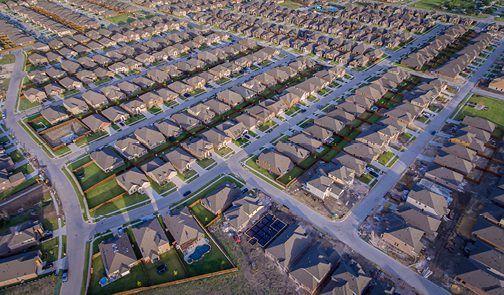The Impact of the Next Recession on the Multifamily Market

In this issue of the Advisory we address the vulnerability of the rental housing market to the next recession with a particular focus on the multifamily market, in terms of the likely impacts on overall demand, rents and occupancies. As we pointed out back in our May 2, 2019 Advisory, it’s important to remember that while the last recession had a dramatic impact on housing, other recessions have had much more modest impacts.
Given the many differences between the economic conditions and housing market of 2008 and today, few analysts expect the next recession to have similarly devastating impacts. Nonetheless, it’s important to consider how severe the next recession is likely to be, and to prepare for the most likely impacts. History tells us that recessions have had an adverse impact on rental housing markets and capital market conditions, but that except for the recent “Great Recession” and the early 1970s recessions, in most recent recessions rental housing production contracted moderately, rent declines were modest and short lived, and vacancies briefly increased but by limited amounts.
It seems likely given the historical relationship between economic recessions and the rental housing market, low overall rental housing vacancies, and strong renter household growth, that any negative impacts associated with the downturn will likely be related to significant changes in the pipeline of new rental housing more than a direct result of the changing economic conditions brought on by recession. RCLCO believes it will be possible for owner/operator/developers who are disciplined to work through the next recessionary period and remain profitable.
The technical definition of a recession is two consecutive quarters of negative economic growth as measured by GDP, although the National Bureau of Economic Research (NBER) takes other factors into account in calling recessions. The precise timing of the next recession is unknown, but given the length of the current economic expansion, we know we’re closer to it now than we were a year ago. In RCLCO’s latest biannual Sentiment Survey published in June 2019, approximately 9 out of 10 survey respondents (88%) believe the downturn will not occur until 2020 at the earliest, with 57% not predicting the downturn until 2021 or later. Of course that was prior to the latest round of escalations to the trade war between the U.S. and China. According to Moody’s Analytics, the trade war has already done meaningful economic damage to the U.S. and global economies, noting that the most recent group of Chinese imports to have tariffs imposed is comprised primarily by consumer goods, and that the trade war has the potential to push the U.S., Europe, and emerging markets into recession.
The chart below shows the historical relationship between job growth and multifamily permits:
Figure 1: Job Growth and Multifamily Permits
Source: Axiometrics
As shown on the chart above there was a substantial drop in permits issued for new units following the job losses of the Great Recession of 2008 – 2009. Since the recovery in 2010 the ratio of jobs to multifamily permits has averaged 6.8 jobs/permit; for the last five years the ratio has been about 6.2; year to date 2019 the ratio is 4.5, as we have been experiencing some softness in the economy and the annualized rate of job growth has slowed. During the earlier part of the recovery, multifamily permit growth lagged behind the pace of job growth but more recently has caught up. If year to date job growth continues at the same pace, then the pace of new multifamily permits may be inching ahead of job growth.
The multifamily market is of course a subset of the overall rental housing market; of the 46 million rental housing units in the US, about a third are in larger rental apartment buildings (defined by the Census Bureau as having more than 10 units). Multifamily rental housing has become a larger part of the overall new housing market post Great Recession. Multifamily construction peaked in 2015 and 2016 but remained strong in 2018 with 344,700 completions and year to date 2019 does not appear to be far off the 2018 pace. Other rentals include units in smaller buildings, single family detached homes for rent, etc.
The following table shows the impact of six past recessions on GDP, on the number of multifamily permits issued, and on overall rental housing vacancies. It’s no surprise that the 2008 – 2009 recession had the greatest impact, even surpassing the 1973 to 1974 recession, which was brought on by the oil crisis. As shown on the chart, most recessions had an impact on permits pulled for new construction and in some cases, on overall rental housing vacancy rates as well.
Figure 2: Past Recessions Impact on GDP, Multifamily Permits, and Rental Housing Vacancies
Source: RCLCO
Note: Change in multifamily permit issuance is the change in the initial year of the recession; rental housing vacancy rates are the average for the time period indicated, for all rental housing.
With the last recession, professionally managed apartments reported rent declines in the range of -4% to -4.5%. Rents started growing moderately again by the fourth quarter of 2010 and more substantially in 2011. Occupancies also fell to their lowest point in a decade, with professionally managed properties dropping from over 96% to just over 92% occupancy. This took place despite the fact that with the last recession, homeownership fell from 69% to 64%, creating many more renter households. The recession also resulted in a large inventory of formerly for-sale housing units being added to the rental housing stock.
As we anticipate future economic impacts, its important to consider the changing demographic context. Growth in renter households earning over $75,000 annual income has increased by about 4.6 million households since the end of the great recession, helping to maintain strong demand for new apartments, and growth in new renter households is expected to average about 400,000 households annually over the next ten years. [1] The largest generation presently active in the housing market, the Millennials, continue to have a lower homeownership rate at this point in their lives than earlier generations, positively impacting the rental housing market. While surveys show that 75% would like to become homeowners at some point, overall the growth in the homeownership rate is stagnant, and it is unlikely to return soon to the levels seen during the last housing boom. Millennials entered the housing market in a period where student debt is greater, lending standards are more stringent, and new for-sale housing affordability is low. While some prefer to be renters, choosing that lifestyle, the fact that they came of age in one of the most difficult economic periods factors into their decisions for delaying marriage and family life, key triggers for home purchases. It is likely that more of the Millennial generation will remain renters longer than earlier generations, and some may not move over the for-sale side of the market for a long time. If and when the next recession comes, it is likely to result in higher levels of unemployment and lower wage growth, which will impact the youngest and least experienced workers the greatest, potentially further slowing their transition to the for-sale market. While younger households continue renting at higher than historical rates, the aging of the population is increasing the proportion of households comprised of childless singles and couples, contributing to increases in the numbers of older renters as well.
Household growth has recovered to about a 1.2 million households per year, but the residential development industry overall has barely kept pace, particularly on the for-sale side where many new households are priced out of the new home market. In the past, new housing production was typically greater than household growth by about a third, to account for replacing obsolete stock, also accounting for the second home and vacation home markets, and to maintain normal vacancies. Lenders, builders and developers are more cautious since the last recession so that is no longer the case, and that is reflected in housing vacancies which remain historically low, even with multifamily production picking up substantially about 2015 and continuing that strong pace to date.
Figure 3: Historical Housing Vacancy Rates by Tenure
Source: U.S. Census Bureau, Current Population Survey/Housing Vacancy Survey, July 25, 2019
Despite the strong rental housing production of the past five years, rental occupancies in professionally managed properties are strong. RealPage reported recently that average apartment occupancy rate in the U.S. rose to 96.2 % in July, levels not experienced since 2000 when occupancies reached 96.6%. Perhaps as a result of recession concerns, given the uncertainties resulting from the U.S. trade war with China, apartment owners and operators may be more focused on driving occupancies than rents, to better position themselves for the eventual downturn. Early in 2019 it was anticipated that slightly fewer units would be started than in 2018, in anticipation of economic slowing and given what was expected to be a higher interest rate environment that would push up mortgage and cap rates. Year to date, multifamily permits on an annualized basis are slightly below 2018, but with the recent interest rate cuts lenders are reporting increased mortgage demand compared to 2018, which suggests the pace may not in the end be that dissimilar to 2018. In any case, the current high occupancies will help to position the apartment market for the recession if and when it arrives.
Despite the strong rental housing production of the past five years, rental occupancies in professionally managed properties are strong. Perhaps as a result of recession concerns, given the uncertainties resulting from the U.S. trade war with China, apartment owners and operators may be more focused on driving occupancies than rents, to better position themselves for the eventual downturn.
While much has been made of the for-sale housing market’s inability to serve the lower end of the market, with most new rental apartment construction targeting the higher end of the market, the rental market is facing its own affordability crisis. Almost half of renter households are cost burdened, which HUD defines as those who pay more than 30% of their income for housing, and renters comprise the majority of households considered severely rent burdened, defined as paying more than 50 percent of one’s income on rent. This is not just a problem facing low income renter households, particularly in expensive rental housing markets in the West such as Los Angeles, San Francisco and Seattle where large numbers of middle-income renters ($45,000 to $75,000 range) are rent burdened.[2] Similar to the for-sale housing market, addressing the affordable end of the market is where the greatest market demand opportunities are, but is also the most challenging to address given the costs of land, materials, and labor. There are some very interesting alternative products such as co-living units, microunits, etc. that have increased their presence this housing cycle and tend to bring down the absolute rent for a tenant while driving up the revenue per foot for a developer, a win/win that helps address the need for more affordable rental housing. In high cost markets in particular, developers have responded to high rents by making units smaller and more efficient, and it’s clear from the high occupancy rates of these smaller units that renters readily accept them.
New housing demand for both the for-sale and for-rent markets will be primarily driven by growth among households in their mid-30’s to mid-40’s, and older households in their 60’s. While the younger group will include families with children, along with singles and couples, the older group will primarily increase the ranks of childless households. Although many older households will age in place, these older households represent a sizeable target for the multifamily housing market. The demand for single family rentals is strong, and despite widespread interest, new purpose built SFR supply represents a small part of the overall rental housing market with much room for expansion. Given the challenges that the for-sale housing industry has faced with delivering sufficient new product for first time home buyers, single family rental housing has the potential to fill a significant gap.
It seems likely given the historical relationship between economic recessions and the rental housing market, low overall rental housing vacancies, and strong renter household growth, that substantially negative impacts associated with the downturn will likely be related to significant changes in the pipeline of new rental housing more than a direct result of the changing economic conditions brought on by recession. RCLCO believes it will be possible for owner/operator/developers who are disciplined to work through the next recessionary period and remain profitable. Smart players should consider some or all of the following strategies, depending on their particular assets:
- Prune portfolios, including land, where appropriate to decrease risk
- Build modest cash reserves
- Limit or decrease leverage levels on assets where market/sub-market conditions present higher risk of overbuilding, potentially shifting leverage to more stable assets
- Create future borrowing capacity (lines of credit) at the entity level
- Be particularly diligent in underwriting value add programs, or honest about CapEx that may be defensive rather than driving higher NOI
- Focus on stabilizing and enhancing tactical property management or property management relationships
- Manage overhead by outsourcing non-core functions, or operational areas where you do not have a competitive advantage
Although the impact of the next recession on multifamily is likely to be moderate, it’s obviously still important to understand the potential influences and to plan for the possibility of a period of slower rent growth and possibly lower occupancies, between now and 2021.
Article and research prepared by Gregg Logan, Managing Director.
References
[1] [2] Harvard Joint Center for Housing, State of the Nation’s Housing, 2019
Disclaimer: Reasonable efforts have been made to ensure that the data contained in this Advisory reflect accurate and timely information, and the data is believed to be reliable and comprehensive. The Advisory is based on estimates, assumptions, and other information developed by RCLCO from its independent research effort and general knowledge of the industry. This Advisory contains opinions that represent our view of reasonable expectations at this particular time, but our opinions are not offered as predictions or assurances that particular events will occur.
Related Articles
Speak to One of Our Real Estate Advisors Today
We take a strategic, data-driven approach to solving your real estate problems.
Contact Us









